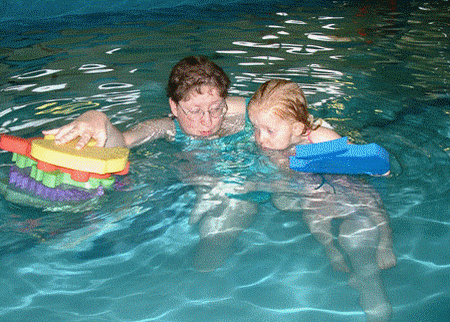When teaching a child to swim, you must remember that it is equally important for the child to learn how to blow bubbles as it is to hold the breath. When the body is floating horizontally, the reason it stays up is the lungs are full of air, and that gives the body buoyancy. After teaching hundreds of adults to swim, I have come to realize that when I ask my pupils to take a big breath, there was some kind of communication problem, because the result never satisfied me. Taking a big breath for a nonswimmer is different from taking a big breath for a swimmer. The best way to describe how to take a breath as a swimmer is to imagine you have a cold and your breathing is stuffed up. You put a towel over your head, and deeply inhale steam and medication through your mouth. This is the kind of deep breathing, through the mouth, that is used in swimming. The blowing out has to be equally forceful and through the mouth. If water goes into your nose, it’s because by mistake you are partially breathing through the nose, rather than just the mouth. It’s just like sucking a drink through a straw.
Ask your pupil if he can blow a bubble. If he says no, tell him, “Pretend you are blowing out your birthday candles.” Many times I sing “Happy Birthday to You” as accompaniment to this effort. Another way is to take his hand and blow hard onto his wet skin. From this he will feel the air on his hand and will know what “blow” means. Still another way for him to feel the impact of the air coming through the water is to put your hands cupped underneath his mouth so that when he blows he can see it, hear it, and feel it.
For some strange reason, when I say to a child, “Close your mouth,” it immediately opens up. To overcome this, I have found if I put my fingers on his mouth and say, “Mmmm Mmmm Mmmm Mmmm,” it works every time.
When you want him to put his face in the water and hold his breath, you say, every time, “Take a big breath, close your mouth, Mmmm Mmmm Mmmm Mmmm. I’m going to count to five.” Not only do you have to repeat the instructions every single time, but when saying “Take a big breath,” you yourself should take an enormous breath as well.
Don’t ask the impossible. If you are just starting off with three seconds under the water and you know the child can hardly do it, don’t say, “Now that you have held it for three, let’s try and make it ten.” (Remember, when the head is under the water, sounds from above can still be heard.)
When the child is holding his breath, insist on his eyes and ears being under the water. It is too early, at this stage, to ask him to open his eyes under the water. This will come later. If you are having difficulty in getting his head under the water during the lesson, this is where helpful parents come in.
Here are a few methods that can be practiced with parent supervision at home:
1. Face in the bathtub water, holding his breath up to the count of five or more.
2. Blowing bubbles at regular intervals.
3. Opening his eyes under the water. Show him colored objects under the water.
4. Alternate between having a shower and a bath. The shower shouldn’t be full on, but insist on the child being right underneath. Give her plastic bottles to fill, have her wash dolly’s hair under the shower, or let her engage in other play activities.
